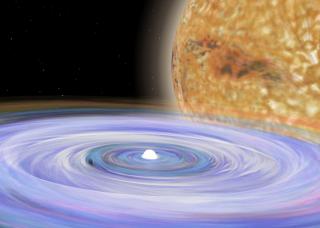Bibcode
Rodríguez-Gil, P.; Shahbaz, T.; Torres, M. A. P.; Gänsicke, B. T.; Izquierdo, P.; Toloza, O.; Álvarez-Hernández, A.; Steeghs, D.; van Spaandonk, L.; Koester, D.; Rodríguez, D.
Referencia bibliográfica
Monthly Notices of the Royal Astronomical Society
Fecha de publicación:
3
2020
Número de citas
13
Número de citas referidas
13
Descripción
We obtained time-resolved optical photometry and spectroscopy of the nova-like variable KR Aurigae in the low state. The spectrum reveals a DAB white dwarf (WD) and a mid-M dwarf companion. Using the companion star's i-band ellipsoidal modulation we refine the binary orbital period to be P = 3.906519 ± 0.000001 h. The light curve and the spectra show flaring activity due to episodic accretion. One of these events produced brightness oscillations at a period of 27.4 min, that we suggest to be related with the rotation period of a possibly magnetic WD at either 27.4 or 54.8 min. Spectral modelling provided a spectral type of M4-5 for the companion star and T1 = 27,148 ± 496 K, log g=8.90 ± 0.07, and log (He/H)= -0.79+0.07-0.08 for the WD. By simultaneously fitting absorption- and emission-line radial velocity curves and the ellipsoidal light curve, we determined the stellar masses to be M1 = 0.94+0.15-0.11 M☉ and M2 = 0.37+0.07-0.07 M☉ for the WD and the M-dwarf companion, respectively, and an orbital inclination of 47+1°-2°. Finally, we analyse time-resolved spectroscopy acquired when the system was at an i-band magnitude of 17.1, about 1.3 mag brighter than it was in the low state. In this intermediate state, the line profiles contain an emission S-wave delayed by ≃0.2 orbital cycle relative to the motion of the WD, similar to what is observed in SW Sextantis stars in the high state.
Proyectos relacionados

Estrellas Binarias
El estudio de las estrellas binarias es una parte esencial de la astrofísica estelar. Una gran parte de las estrellas de nuestra Galaxia y de otras galaxias se ha formado en sistemas binarios o múltiples, por lo que entender la estructura y evolución de estos sistemas es importante desde el punto de vista estelar y galáctico. Un aspecto en el que
Pablo
Rodríguez Gil